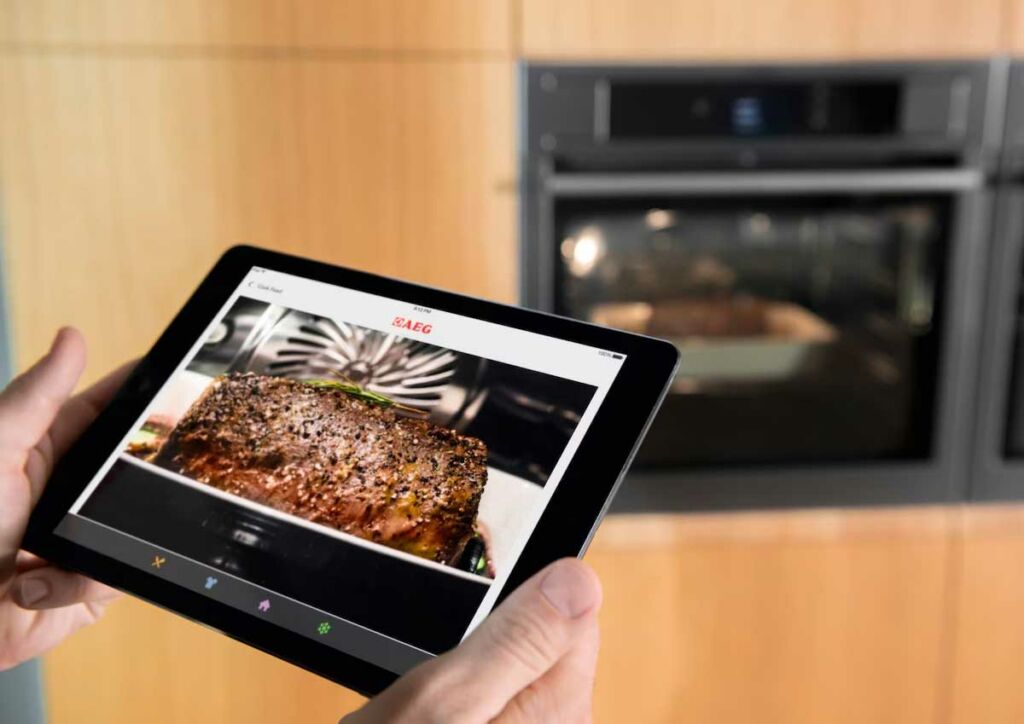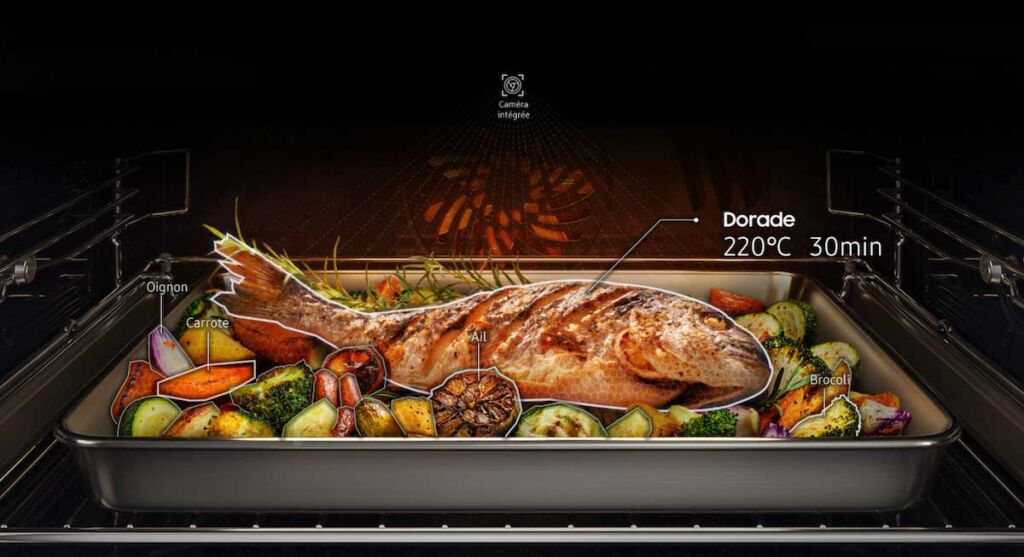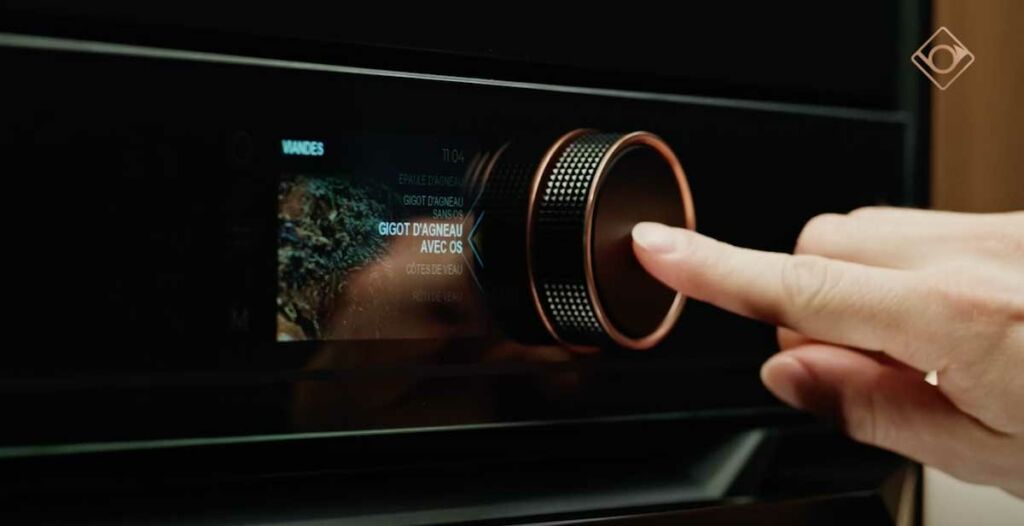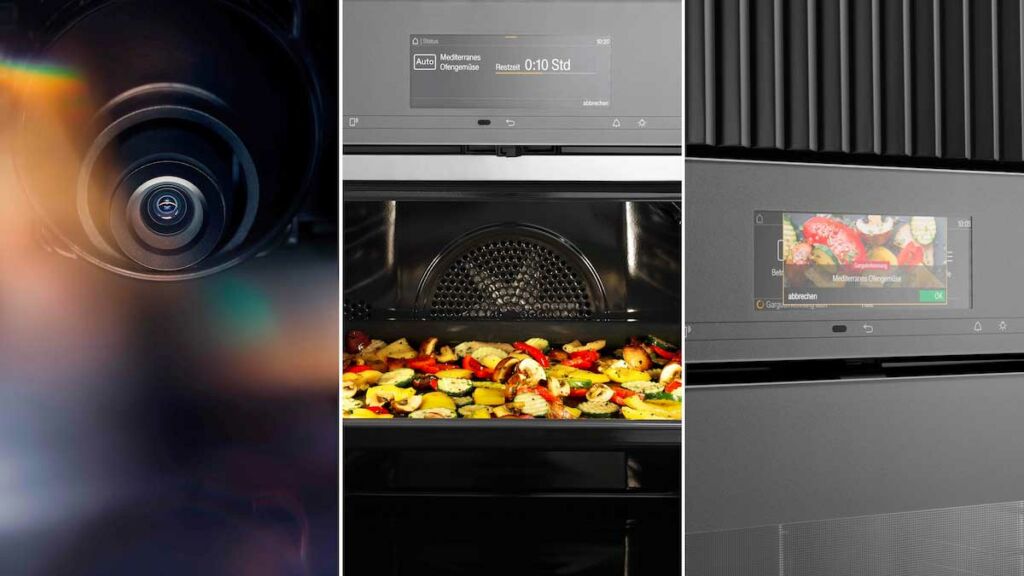Artificial intelligence is gradually invading all home equipment, including household appliances. Among these, the ovens seek to take advantage of it in a relevant way. And the latest advances in this area are promising. Decryption.
THE fours connected are not new. But some of the possibilities they offer can leave you perplexed, such as controlling the parameters of your oven from your smartphone. We can indeed wonder if this is not a bit of a gimmick. In recent years, thanks to algorithms that rely on artificial intelligencethese cooking appliances have reached a milestone. The promise no longer lies (only) in remote control, but in user assistance, to help them obtain perfect cooking results, whether they are an amateur or a novice in the kitchen.
Haier’s smart ovens, equipped with a camera, are able to identify around 35 recipes – so far.©Haier
Dish recognition and automated cooking monitoring using AI
These ovens naturally offer the same functionalities as older generation connected models: step-by-step recipe monitoring on the application then automatic transmission of cooking parameters to the oven, monitoring of cooking from the application (via a timer or possibly a camera if the oven has one), remote control from the application (temperature, start, stop, etc.) and, more interestingly, a self-diagnosis in the event of a breakdown or malfunction.
Some models equipped with cameras also allow you to watch the cooking of the dish live in the application, or even record a video to share on social networks. Regarding all the control or viewing functions from a smartphone, each user is free to find a use for them or not.
 Older generation AEG and Electrolux ovens included a camera, which made it possible to view the dish during cooking from your smartphone or tablet. ©AEG Electrolux
Older generation AEG and Electrolux ovens included a camera, which made it possible to view the dish during cooking from your smartphone or tablet. ©AEG Electrolux
In addition to the functions mentioned above, the latest generation models using AI are able to identify certain dishes or foods when they are put in the oven, thanks to an on-board camera. They then suggest the most suitable mode, as well as the appropriate cooking temperature and duration. They thus position themselves as intelligent cooking assistants.
Most of them also monitor the progress of the cooking using their camera, checking the degree of browning, and stopping it when the dish is perfectly cooked. Among the devices that offer such intelligent functions, we can cite the models of the ID Series 6 range of Haier (being launched from around €1000) which use this technology under the name Bionic Vision (all of the intelligent cooking technologies are called Bionicook).
Samsung offers exactly the same functions under the name AI Pro Cooking on the references of its Bespoke AI range. Same for Miele on its 7000 series ovens equipped with a camera – this time the technology is called Smart Food ID. On the oven Hisense Hi9 (which is scheduled to be commercialized at the end of 2025), is AI Baking technology – the marketing name is different, but the functions are the same.
 Recording time-lapse cooking videos is one of the “bonus” features offered by the Samsung SmartThings app.©Samsung
Recording time-lapse cooking videos is one of the “bonus” features offered by the Samsung SmartThings app.©Samsung
As for Bosch et Siemensthese sister brands use slightly different solutions, not based on cameras, but on sensors. This time, it is not the color of the food during cooking that is monitored, but the humidity level in the cavity to adjust the temperature and stop the oven when the dish is ready. No automatic food recognition here; you have to manually enter the type of dish and its weight so that the oven manages the rest.
 No dish recognition on De Dietrich ovens; you must indicate what you are cooking. ©De Dietrich
No dish recognition on De Dietrich ovens; you must indicate what you are cooking. ©De Dietrich
AI Talent Sensor technology developed by De Dietrichit also uses sensors to analyze the humidity level of the dish, but automatically detects the weight and volume; simply select the type of food before starting cooking.
Increased personalization of cooking
The main promise of these technologies is to assist the cook to guarantee always perfect cooking. The goal is not only to make everyday life easier, but to ensure the best performance. Personalization is also part of the commitments.
Haier is undoubtedly the brand that is most committed to this point. Indeed, through connectivity, it promises that its smart ovens learn the user’s tastes in culinary preparation. How ? When he makes a specific recipe – lasagna, pizza, gratin dauphinois, roast chicken, etc. –, if he continues cooking for a few minutes so that the dish is more cooked or more grilled and he does it several times , the device considers that it is its preference (after three times for the same recipe). It therefore adjusts the cooking time and applies it when the cook prepares this recipe again.
As for Samsung, the manufacturer relies on its Samsung Food application (compatible with its smart ovens) to offer a personalized experience. Thanks to AI, it goes a little further than most recipe apps which make personalized suggestions based on the ingredients available or dietary preferences. It can recognize foods from photos, allows you to save your own recipes in the same format as others or can even adapt recipes to eating habits (by replacing meat with another ingredient for vegetarians, for example) .
 At Miele, the AI function is called Smart Food ID. On the program: food recognition, automation of cooking parameters and monitoring of browning.©Miele
At Miele, the AI function is called Smart Food ID. On the program: food recognition, automation of cooking parameters and monitoring of browning.©Miele
New in smart cooking
During the last IFA show, which took place in September, this trend towards the use of AI in cooking appliances was confirmed. But Electrolux/AEG, which has unveiled a new range of built-in ovens, has chosen to exploit these smart features in a different way that we think is really interesting.
Competing technologies currently have some limitations. The first lies in the recognition of foods – most ovens are currently capable of identifying a little over thirty. This will obviously evolve, but, initially, not all recipes can be prepared using automatic recognition.
As for the transmission of cooking parameters from the application to the oven, it is certainly practical and the recipes are perfectly calibrated for the device. But, in most cases, this limits the choice to the recipes offered in the dedicated application. However, many consumers look for inspiration on different websites, which does not allow them to take full advantage of the functionalities of their oven. For example, there are few recipes using the steam functions, which nevertheless tend to become more widespread.
 The new Electrolux/AEG application also promises time savings and tips to promote energy savings.©AEG Electrolux
The new Electrolux/AEG application also promises time savings and tips to promote energy savings.©AEG Electrolux
Electrolux/AEG has therefore chosen to use AI for this purpose: to adapt any recipe to its ovens. As is often the case, all the intelligence is embedded in the application. The manufacturer, who named this AI technology TasteAssist (common to the ovens of the two brands), speaks of an intelligent culinary assistant. One can copy the link of any recipe from the internet and paste it into the app. This is responsible for reading it, interpreting it and “translating” it to adapt it to the oven and obtain an optimal result, taking into account its characteristics and functionalities.
It can readjust the cooking time, temperature or mode. She may also suggest adding steam to improve the cooking of a cake or meat that needs to be toasty on the outside and soft on the inside. The technology will be available on the next ranges of AEG and Electrolux ovens which will be marketed in spring 2025 (from around €1,200).
The proposal seems both interesting and judicious to us, because, although it remains necessary to use the brand’s application, it does not “lock” the user into recipe choices. Which allows intelligent cooking to take a step forward. The real relevance of the solution will of course depend on the ability of the application to fully understand all the recipes and readapt them judiciously.

